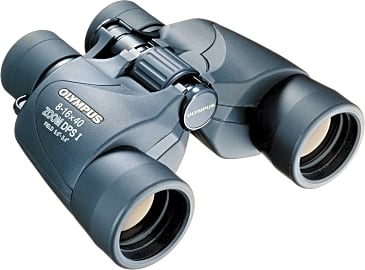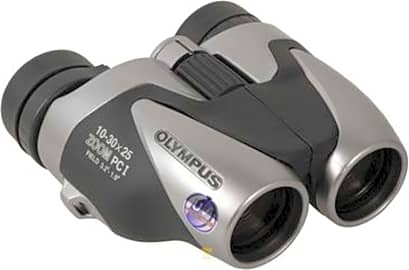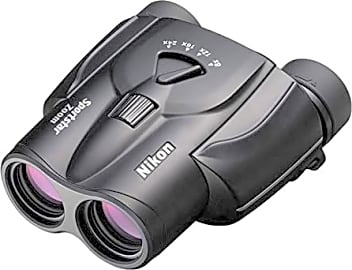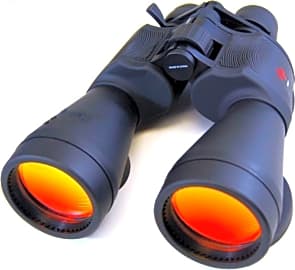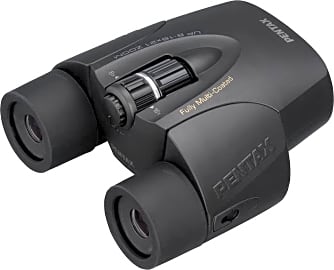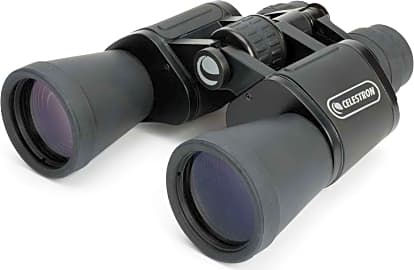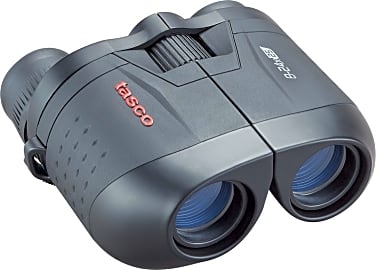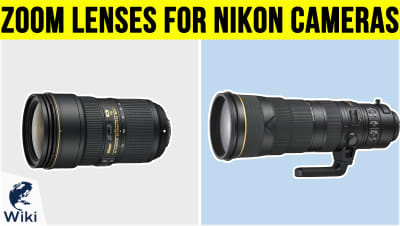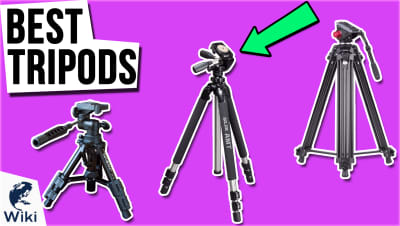The 10 Best Zoom Binoculars

This wiki has been updated 36 times since it was first published in April of 2016. Whether you're an amateur ornithologist, an avid concert-goer, or a budding astronomer, the zoom binoculars on our list will bring the images of animals, rock stars, and celestial objects up-close. By operating within a defined range, each pair lets you fine-tune your field of view without having to move, and we've ranked them here by magnification, light transmission, and durability. When users buy our independently chosen editorial choices, we may earn commissions to help fund the Wiki.
Editor's Notes
October 29, 2020:
While there weren't a lot of big changes in this category, there was something a little odd from Nikon. The Nikon Compact Aculon have been replaced by the Nikon Compact Sportstar, but the difference between the two models is unclear. One clue comes from the company's previous Aculon listing, which includes the specific mention of Bak-4 prisms — generally among the best you'll see in binoculars of this price range. Nikon has been a bit cagey about the nature of the prisms in their new Sportstar line, save to say that they're porro prisms. Interestingly, while the performance of either model is almost identical, the Sportstars do seem to lose a little more light at the far end of their magnification range than the Aculons do, suggesting that either an increase in coatings or a reduction in prism quality has occurred. Either way, the difference cost the company its previous standing in our consideration.
Leica seems to have discontinued the Leica Sport Optics Duovid we previously included in our special honors section, through the reasoning behind that decision is unclear. In their place, we've introduced the ATN Binox 4K, a night vision set with rangefinder capabilities that can communicate with the company's rifle scopes to help you home in on a given target.
November 14, 2019:
A few of the models on our previous list have run into availability issues, and a common theme among them is that they didn't necessarily come from companies with history and reputation. They were among the upstart brands coming out of foreign factories that made a product that was good enough, and that was very well-priced, but that ultimately wouldn't last. We've done what we could to purge those types of products from the current iteration of our list, keeping to recognizable brands in the optics field like Nikon, Celestron, Pentax, and Olympus.
The Nikon 8252 Aculon A211 may very well represent the best balance of features in a zoomable pair, as their range isn't so comical as to imply sharpness issues, and their objective lenses are large enough, precisely ground enough, and coated enough to ensure great light transmission. This is, after all, a company that makes some of the finest camera lenses on earth.
You might also notice a definite preference for porro prisms over roof prisms in the majority of our list. That's due to their increased contrast and more reasonable price point. Adding a zoom function to a set of high-quality roof prism binoculars would likely make them prohibitivly expensive to the bulk of consumers. There's a prime example of one such wildly expensive pair in our special honors section.
Special Honors
ATN Binox 4K This digital pair features a 4-16x zoom range and the ability to record video at 1080p, but also offers night vision capabilities with IR emitters to illuminate the area in front of you. They even have the ability to act as rangefinders and to communicate wirelessly with the company's rifle scopes and share ballistic information you can use when setting up a shot. atncorp.com
Choosing The Best Zoom Binoculars
Some models are equipped with a rubberized shell meant to take a beating and still operate.
Zoom binoculars vary greatly, and understanding the differences between their features can help to ensure you choose the best model. The first thing to be aware of is magnification numbers. Higher magnifications are best for looking at objects that are extremely far away. Another consideration is objective lens optics. Bigger objective lenses mean more light and a brighter image, so they are better for low-light situations. They also make for heavier binoculars. This is why many bird watchers and hikers choose smaller objective lenses to save on weight. In well-lit situations, such as sporting events or concerts, a smaller objective lens size shouldn't be an issue, so it may also be more ideal to have a compact model with a very small objective lens.
Some models are equipped with a rubberized shell meant to take a beating and still operate. This additional armor may increase the size, weight, and price. Users who need a simple pair of binoculars to use from the safety of their stadium seat may favor a lighter, unprotected model.
Depending on your uses, you may require a pair of waterproof binoculars. This is especially important if you intend to use them in high humidity environments or in an environment where rain is frequent, as water can easily damage standard binoculars.
Field of view is another factor for many users. Just as with normal vision, a wider field of view is more desirable for people who need to follow something moving across their viewing area. This could be a ball at a sporting event or quick moving wildlife. For people who usually view stationary objects, a wide field of view is not as important.
History Of Zoom Binoculars
Modern zoom binoculars are a pair of powerful telescope lenses adjusted to be used with both eyes. As such, the history of binoculars actually goes all the way back to the first telescope. A man from Holland named Hans Lippershey is credited with the invention of the telescope somewhere near the beginning of the 17th century. He was not the first to make telescopes, but he was the first to make them well known. Early telescopes consisted of one convex lens and one concave lens fixed at opposite ends of a tube. This allowed for objects to be magnified three to four times. Lippershey put two of these tubes together to make a very rough version of binoculars, but they were difficult to use correctly and fell by the wayside.
Old lenses were made of glass, which provided blurry images and low magnification.
The telescope was a bit of a novelty when it was first introduced, but soon many fields realized its benefit. The Italian mastermind Galileo Galilei improved upon the design and used his perspective tube to study celestial bodies. With his telescope, Galileo was the first man in modern history to see the craters of the moon, the four largest moons of Jupiter, and even the rings of Saturn. Almost a hundred years later, Sir Isaac Newton revolutionized the telescope by adding a simple mirror. This reflector telescope would open the door to modern telescopes, magnifying glasses, and even binoculars.
Around this same time, Johann Zahn made the first handheld binoculars that had an adjustable link between the two telescopes. This was still a very rough approximation of true binoculars. Old lenses were made of glass, which provided blurry images and low magnification. J.P. Lemiere invented the first true binocular telescope in 1825. It was used by the U.S. Navy in the Civil War, but was replaced as the most defining invention in binoculars, the Porro prism, was developed in the 1850s. The Porro prism paved the way for all modern binoculars, and is still used to this day. Modern binoculars continue to improve on the original designs, though the concept of two telescopes being mounted together to be used with both eyes is well over 400 years old.
Understanding Lenses And Prisms On Zoom Binoculars
Lenses and prisms on zoom binoculars can seem complex, but they are simple to understand with a bit of guidance. The markings on a binocular will determine the magnification and aperture of the lens. If a binocular is marked 10 x 50, it will have a magnification power of 10. This means objects will appear ten times closer than they actually are. It is more difficult to keep the field of view steady with higher magnification numbers, as they also amplify the movements of the user’s hands, making for a shaky field of view. Binoculars above a 10 magnification are usually used with a tripod or stand. The difference with zoom binoculars is that they provide the user with a range of magnification options. This eliminates the need for multiple sets of binoculars depending on what the user is viewing. Many models can comfortably switch from seven or eight times magnification all the way up to fifteen or sixteen times.
Porro prisms create the typical offest look of classic binoculars.
This same pair of binoculars will have a 50-millimeter objective lens. The purpose of the diameter of the objective lens is to absorb light and reflect it to the eye. Larger lenses will provide a brighter image, where smaller lenses will rely more on the light levels of the environment.
Zoom binoculars also employ either Porro prisms or roof prisms. Prisms in lenses disperse light, flipping and mirroring images so they appear upright in the lens. Porro prisms create the typical offest look of classic binoculars. They are slightly less durable and compact than other prism types. Reverse Porro prisms improve the profile of binoculars and make them more compact.
Roof prisms are gaining popularity in the lens industry, as they relay an image, without affecting the profile of the binoculars. Advancements in prism design have made roof prisms extremely accessible, creating a high optical quality without compromising on price or size. The highest quality optical glass is now regularly used to create a clear, highly resolved image in the lens. Lenses are commonly marked extra-low dispersion, high definition, or alpha-class to denote that their glass creates crisp images and reduces color fringing.



